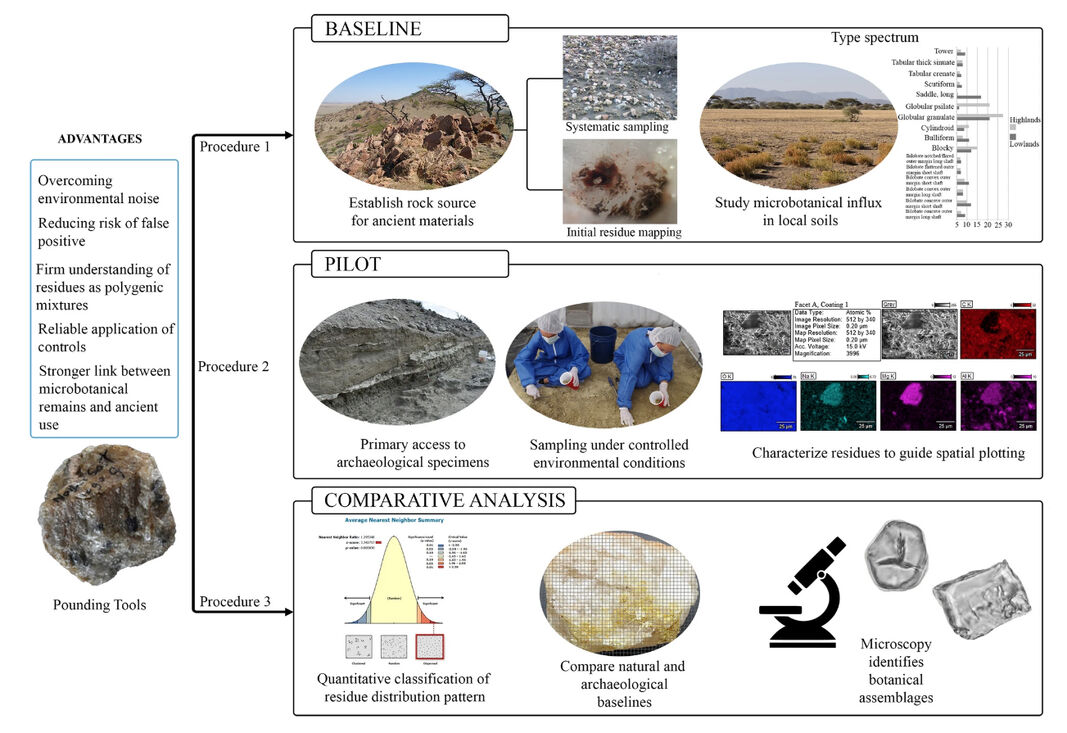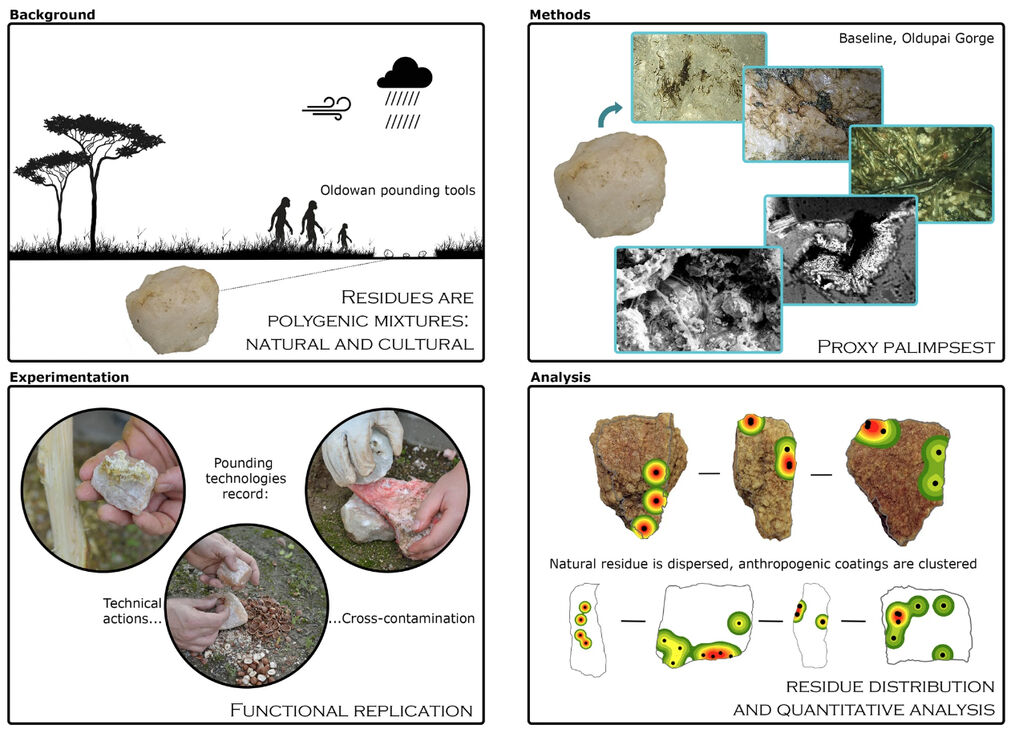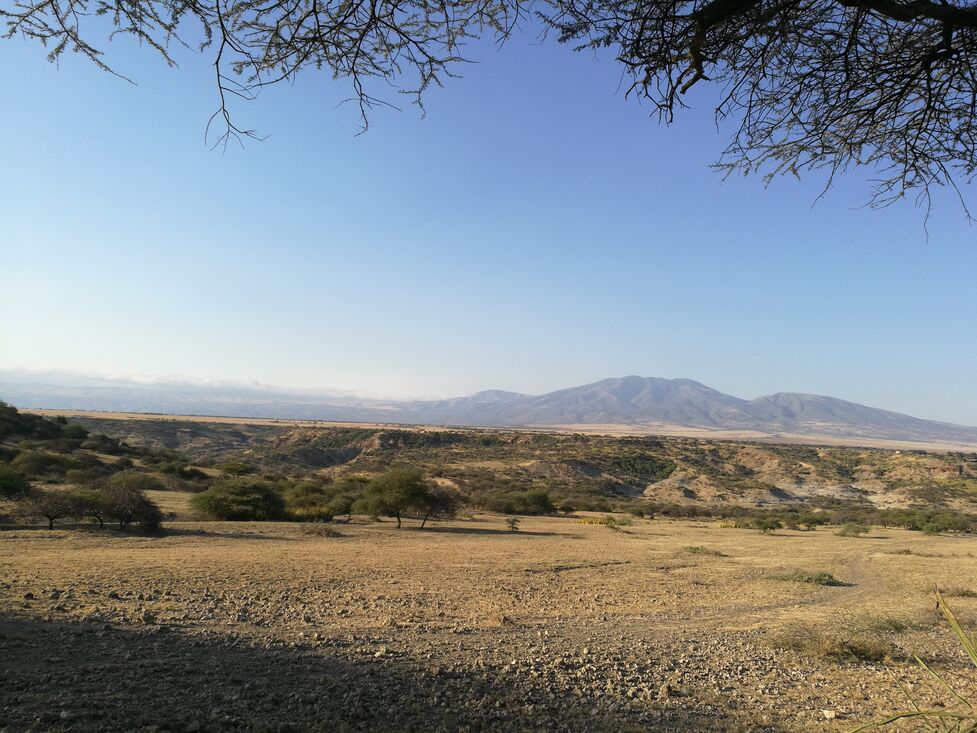Advances in the study of microbotanical residues in the early hominin stone tools
An international research group led by Julio Mercader (Univ. of Calgary and research associate at IPHES) and with the participation of Andreu Ollé (IPHES and URV), María Soto (MIAS - UAM), Juan Luis Fernández Marchena (UB and IPHES) and Antonella Pedergnana (Univ. Zurich) have just published an innovative method for identifying microbotanical residues attached to the stone tool surfaces. The paper, published at Scientific Reports, represents a methodological advance to deep in the plant-processing activities among the first hominins groups.
The research is based on a multidisciplinary vision focused on the identification of microbotanical residues on the surfaces of stone tools. Specifically, the methodological bases presented will allow to advance in the knowledge of the activities of percussion and pounding, characteristic of the Oldowan assemblages.
Over 2 million years ago in East Africa, the tools of the first hominins evolved amidst a changing environment, in which pounding activities played a key role in this adaptation process.
The Olduvai Gorge (now Oldupai), in Tanzania, is a key place for the study of human evolution, where some of the oldest collections of instruments related to pounding activities were discovered. However, direct evidence of the resources processed with these technologies are scarce.
One of the ways to explore these evidences is the study of the residues that may have been preserved adhered to the stone surfaces. However, linking the possible residues identified with the actual activities carried out with these instruments is not an easy task. Regarding plant processing, this link requires a solid starting point, mainly based on the study of reference collections, specifically designed according to the area of interest, and including residues of both anthropic and natural origins.
In this work, the microbotanical remains in fragments of quartzite extracted from the main outcrop frequented by the hominins of Oldupai have been studied. Natural residues were mapped with GIS techniques to objectively quantify its distribution. Different extraction protocols for different types of residues (such as phytoliths, starch and pollen grains, or diatoms) were then applied and the results were compared with those obtained from different soil control samples. Some of the analyzed quartzite fragments were then knapped to elaborate stone tools, replicating pounding activities with different materials.
The obtained results show that, indeed, the lithic supports are powerful environmental reservoirs, in which the plant microresidues are trapped in lithobionts, microhabitats on the rock surfaces, which are preserved through hardened accretions. The use of the stone tools, on the other hand, creates clear accumulations patterns of residues. Its distribution can be easily differentiated from the patterns of the natural residues, thanks to its georeferencing and statistical analysis.
The IPHES-URV research group "Social, cultural, and biological Evolution during the Pleistocene (StEP, SGR20171040) (http://www.iphes.cat/subsistence-technology-and-human-evolution) has contributed to this study creating the collection of experimental tools, performing the microscopic study of residues, applying different techniques of optical, digital 3D and electronic microscopy, and its chemical microanalysis through X-ray spectroscopy (EDS).
The research, result of an extensive transcontinental and interdisciplinary collaboration within the “Stone Tools, Diet and Sociality Project” (Partnership Grant, SSHRC) (https://olduvaigorgesds.com), concludes with the proposal of a protocol and a workflow that allows overcoming the environmental noise, reducing the risk of false positives through safe controls, better characterizing residues as polygenic mixtures, and, most importantly, establishing safer links between microbotanical remains and the use of stone tools.
“We are ready to apply this novel protocol to ongoing studies of archaeological assemblages, not only from Oldupai, but also from other sites such as Sierra de Atapuerca or Barranc de la Boella”, Andreu Ollé points out.
Reference:
Mercader, J., Belev, G., Bushozi, P., Clarke, S., Favreau, J., Itambu, M., Jianfeng, Z., Koromo, S., Larter, F., Lee, P., Maley, J., Fernández-Marchena, J.L., Mohamed, A., Mwambwiga, A., Ngisaruni, B., Kingi, M., Olesilau, L., Patalano, R., Pedergnana, A., Sammynaiken, R., Siljedal, J., Soto, M., Tucker, L., Walde, D., Ollé, A., 2022. Microbotanical residues for the study of early hominin tools. Scientific Reports 2022 12:1. 12, 1–12.
Open Access here




